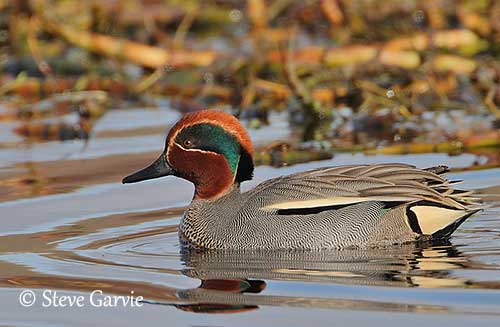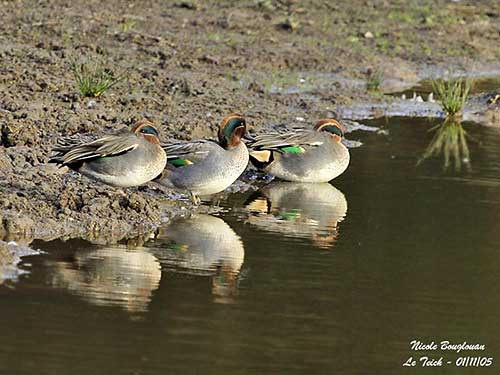
Fr: Sarcelle d’Hiver
Ang: Eurasian teal – Common Teal
All: Krickente
Esp: Cerceta común
Ita: Alzavola
Nd: Wintertaling
Sd: Kricka
Photographers:
John Anderson
John Anderson Photo Galleries
Steve Garvie
RAINBIRDER Photo galleries & Flickr Rainbirder
Nicole Bouglouan
PHOTOGRAPHIC RAMBLE
Text by Nicole Bouglouan
Sources:
HANDBOOK OF THE BIRDS OF THE WORLD vol 1 by Josep del Hoyo-Andrew Elliot-Jordi Sargatal - Lynx Edicions - ISBN: 8487334105
THE COMPLETE BOOK OF BRITISH BIRDS – Written by “Royal Society for the Protection of Birds” experts - Préface de Magnus Magnusson - Michael Cady- Rob Hume Editors - ISBN: 0749509112
THE HANDBOOK OF BIRD IDENTIFICATION FOR EUROPE AND THE WESTERN PALEARCTIC by Mark Beaman, Steve Madge - C. Helm - ISBN: 0713639601
GUIDE DES CANARDS, DES OIES ET DES CYGNES – de Steve Madge - Delachaux et Niestlé - ISBN: 2603013769
ENCYCLOPEDIE DES OISEAUX DE FRANCE ET D’EUROPE – de Peter Hayman et Rob Hume - Flammarion – ISBN : 2082009920
L’ENCYCLOPEDIE MONDIALE DES OISEAUX - Dr Christopher M. Perrins - BORDAS - ISBN: 2040185607
Wikipedia, the free encyclopaedia
Sibley Guides - Distinguishing Green-winged and Common Teal
Natural History of the Waterfowl – Dabbling Ducks
Eurasian and American Green-winged Teal and hybrids: an identification challenge
Bird words - Eurasian Teal (Anas crecca)
National Center for Biotechnology Information - Heteropatric speciation in a duck, Anas crecca
Eurasian Teal
Anas crecca
Anseriformes Order – Anatidae Family
INTRODUCTION:
The Eurasian Teal is now separated from the North American Green-winged Teal that is today a full species. The Eurasian Teal breeding in the Aleutian Islands (race A.c. nimia) is considered a subspecies of Anas crecca and is slightly larger than nominate.
The Eurasian Teal breeds in temperate Eurasia and migrates southwards to spend the winter in warmer regions. It is highly gregarious outside the breeding season, and large noisy flocks are commonly seen in wet areas. It breeds in sheltered freshwater wetlands with tall vegetation, but during winter, it frequents brackish waters and occurs in coastal inlets and lagoons.
This species is threatened by degradation and loss of the habitat. Poisoning, hunting pressure, human disturbances and diseases are today usual threats. But currently, the Eurasian Teal is not globally threatened.

DESCRIPTION OF THE BIRD:
Biometrics:
Length: 34-38 cm
Wingspan: 58-64 cm
Weight: M: 250-450 g – F: 200-400 g
The Eurasian Teal adult male in breeding plumage has finely vermiculated grey and white upperparts and flanks. We can see a white stripe along the sides of the upperparts, more or less conspicuous according to the position of the feathers.
On the upperwing, the wing-coverts are grey with broad terminal yellowish-white to buffish band on greater coverts. The secondaries are metallic green with white tips, forming a conspicuous green speculum. The primaries are dark grey-brown. Tail and uppertail-coverts are black with yellowish-buff triangle on each side.

On the underparts, the breast is pale yellowish-buff with fine dark mottling. Breast sides and flanks are vermiculated grey. The centre of the belly is whitish. The undertail-coverts are buffy-yellow, outlined by black line. On the white underwing, the flight feathers are grey and the lesser coverts are heavily spotted dark grey.
On the head, forehead, crown, nape, cheeks and upper neck are rufous-brown. We can see a broad green band extending from the eye, through the ear-coverts to sides of nape. There is a narrow creamy-white line below the eye, and a second one from the side of the bill base and bordering the rufous-brown forehead and forecrown.
The bill is greyish-black, but it becomes paler at base during the moult. The eyes are brown. Legs and webbed feet are olive-grey to blue-grey.

The adult male in eclipse resembles adult female, but it is usually darker overall, with more indistinct blackish eye stripe.
The adult female has brownish mottled plumage with slightly darker back and rump. On the underparts, breast and belly are almost white with sparse dark mottling. On the upperwing, the bright green speculum is usually visible.
On the head, crown and eye stripe are darker than the grey-brown head and neck.
The bill is grey with dull pinkish to yellowish-orange area at base.
The juvenile resembles female but it has spotted belly. It lacks the buff markings on the uppertail-coverts.

SUBSPECIES AND RANGE:
The Eurasian Teal has two subspecies.
A.c. crecca (described above and displayed) breeds in most parts of N and C Palearctic. It winters in C and S Eurasia and in Africa.
A.c. nimia breeds in Aleutian Islands and does not migrate. This race is named Aleutian Green-winged Teal and is slightly larger than nominate.
The population of “nimia” is estimated to number about 80,000 individuals. This race was first described in 1948. It is year-round an Alaskan resident where it is probably the most numerous duck of Aleutian Islands.
HABITAT:
The Eurasian Teal frequents freshwater pools and lakes with dense fringing vegetation. During the breeding season, it prefers shallow waters and smaller ponds or pools, and mostly open country. It is locally found in upland areas too.
Outside the breeding season, it can be seen in open waters on lakes and reservoirs, but also in estuaries, saltmarshes, river deltas and sheltered coastal bays.
The Aleutian race “nimia” frequents ponds and lakes during summer, but in winter, it frequents mostly marine beaches. It forages at low tide in tide pools and shallow water around reefs.
CALLS AND SONGS: SOUNDS BY XENO-CANTO
The Eurasian Teal male gives a distinctive, soft, liquid, high-pitched and far-carrying whistle “preep-preep”. The female is relatively silent, but she utters a sharp, high, nasal “quack” when flushed.
BEHAVIOUR IN THE WILD:
The Eurasian Teal feeds on a wide range of aquatic food items including plant material such as aquatic plants, grasses and sedges, and grain, mainly cereals and rice during winter. During the breeding season, it feeds primarily on aquatic insects, larvae, molluscs, crustaceans and even fish eggs.

The Eurasian Teal is very active when feeding in typical Anatidae behaviour including dabbling, upending and head-dipping. It rarely dives and only in very shallow water, and filters the mud for invertebrates.
It forms flocks of 30-40 to more than 100 individuals during the non-breeding season. The resting birds may remain motionless for long periods.

The pair-bond is often formed between late January and March. They are monogamous, but the pair-bond is broken each year. Males often outnumber females, involving some extra-pair copulations and frequent aggressive encounters between rivals.
The displaying male makes jerky movements while on the water, often interspersed with spectacular aerial chases above pools and marshes where it breeds. After these elaborate displays, the female performs inciting display close to the chosen male. Both mates perform head-pumping before to copulate on the water.


The Eurasian Teal is migratory or partially migratory. The birds that breed in temperate regions are resident all year round, whereas the northernmost breeders reach lower latitudes in winter, as far South as equator. In Europe, the peak passage is mainly October/November with males first. The return migration may start in mid-January/late February, but it occurs mostly in March/April.
The race “nimia” is generally sedentary, but it is regularly recorded in British Columbia in winter.

The Eurasian Teal has twisting flight with rapid wingbeats. When flying in flocks, the birds often turn in perfect unison like flocks of shorebirds. If flushed, it raises almost vertically, even from the water.
By contrast, it is rather clumsy while walking on the ground.


REPRODUCTION OF THIS SPECIES:
The breeding season takes place in spring/summer, from March/May to at least July in the northern range.
The Eurasian Teal breeds in single pairs or loose groups. The female chooses a well-concealed site for the nest, usually among thick vegetation in sedges or grasses. The nest is a scrape or a natural depression on the ground. She builds a bowl with grasses, twigs and leaves. She usually adds some of her body’s down and feathers. The nest is concealed from predators by the surrounding vegetation that forms a kind of canopy. The nest is built on dry ground or upland moor, usually close to water.

The female lays 10-12 creamy-white eggs and incubates alone while the male abandons her and starts to moult. She incubates during 21-23 days. At hatching, the chicks have dark brown down above and yellow below. The female moves them to water very soon after hatching and she rears them alone. She broods them during the wet and cold periods. The young fledge about 25-35 days after hatching. They can breed at one year old.
PROTECTION / THREATS / STATUS:
Female and young are vulnerable to predators during the incubation and then, while rearing the chicks. But the Eurasian Teal is threatened by habitat loss through wetland drainage, afforestation and other changes. This species is heavily hunted in its wintering areas, and suffers from human disturbance through recreational activities.
The overall population trend in uncertain, with increasing, stable and decreasing populations, but it appears currently stable.
The population of A.c. nimia from Aleutian Islands is estimated to number about 80,000 individuals.
The Eurasian Teal is currently evaluated as Least Concern.
